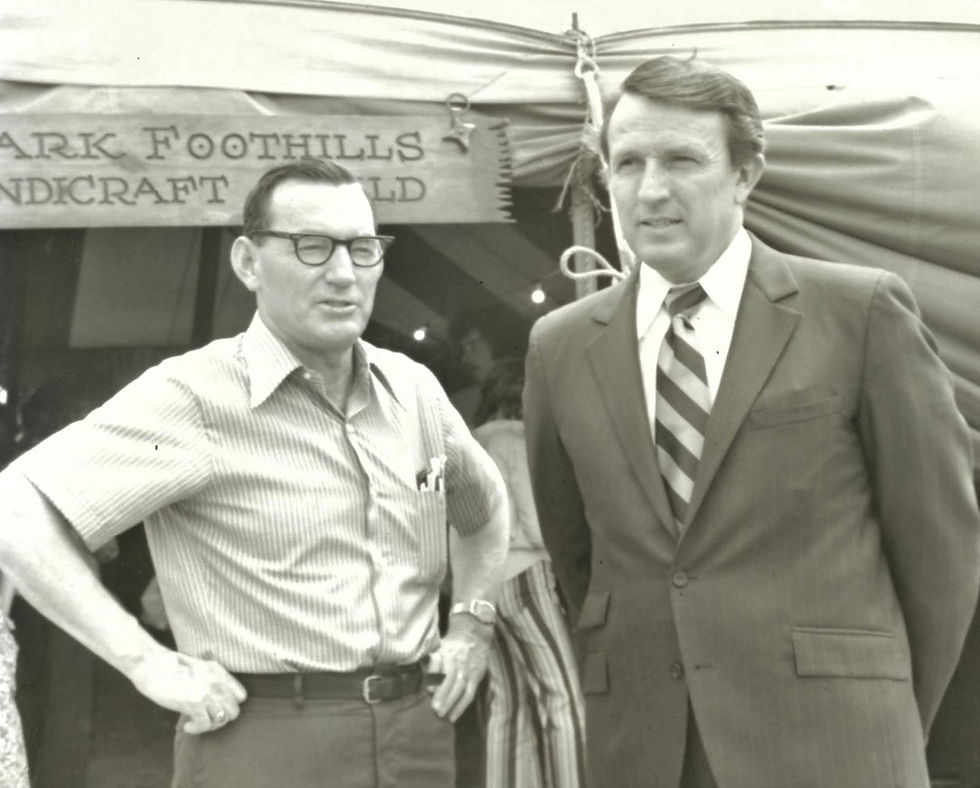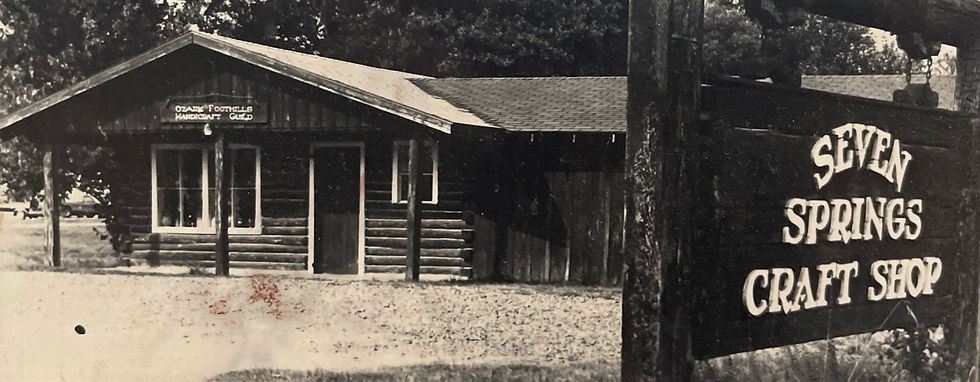
Edwin Luther with Governor Dale Bumpers.
This Ozark Folk Center 50th Anniversary Legacy Photo is in memory of Edwin Luther.
With appreciation for all of your work, Janice Sutton.
Edwin Luther was born in on Christmas Day, 1922, of parents who were both Stone County natives. He graduated from Mountain View High School. He was an insurance agent from 1952 until 1999. While he served on the City Council about 10 years starting in ‘52, the Council and Mayor tried to get industry to come to the area, along with Glen Hinkle, chairman of the Stone County Development Council, Lloyd Westbrook, County Extension agent, and Leo Rainey, Area Rural Development Agent.
Leo described their efforts, “During the summer of ‘61, the Extension Service had little fairs in all the counties with several objectives - to try to find craftsmen, to help the economy and create jobs, and preserve folklore. We discovered at this time, there wasn’t much crafts being done.” In October 1961, the Extension Service and Rainey planned a bus trip with several craft leaders to Gatlinburg, Tennessee to visit the Southern Highlands Craft Guild. When they got back, they organized meetings in seven counties with the idea of forming some kind of craft organization, Izard, Sharp, Fulton, Cleburne, Van Buren, Independence, and Stone.

Edwin Luther is quoted in the Brooks Blevins, Lyon College Regional Studies Center Oral History online, “We got together with the people that were doing quilts, woodwork and baskets, and all these other crafts, and we had a craft show down on Main Street in one of the buildings here in town, with twenty-five to thirty participants.” After the craft show, participants decided to have another one the next year (1963) and they went to Jimmy Driftwood and asked him if he would put on a music show with it.
In September of 1962 the group met at Clinton, in a cabin built by Jim Warren, President of the Guild from ’62-‘64. Articles of Incorporation were filed making the Ozark Foothills Handicraft Guild a cooperative in November 1962. A craft show and festival was planned in Mountain View April of ‘63 in coordination with the blooming ‘dogwood drive’ through the National Forest.
Edwin Luther became a Guild Board member in 1966, was President of the Board 1970-74 and continued in the position of Advisory President of the Board through 1982. His craft was woodworking, but he modestly revealed he did it “just to promote it.” His wife Evelyn was also a Guild crafter.
According to Tommy Simmons: “Jim Warren, Epps Mabry, Les Richardson, Herman Jones, these were some people already involved in crafts. Dorothy Ford was a weaver, Pleasant Grove, Mary Lou Kosmeder at Clinton, a potter, and in our search for craftsmen, we unearthed some craftsmen, and also some of them took training to learn more. They upgraded their skills.” The objective was to improve the reputation of Arkansas crafts to better market handmade items, and has continued throughout the life of the Guild, to learn and teach quality skills.

The Guild built craft shops at Hardy, Heber Springs, Salem, and Clinton to sell members' crafts, These cabins were built by Jim Warren and financed through bank loans. The first store in Mountain View was next to the home of Jim Warren at Rocky Bayou.
Rainey related, “The first Festivals were very exciting, the Craft Guild out at the county Fairgrounds, and Jimmy Driftwood had their music show at the old school gymnasium, drawing a big crowd for folk music which was very big at that time. We then moved down to the old school grounds and put up big tents and had demonstrations out in the area there around those buildings, and those were really good years.“
Lynn McSpadden, founder of the Dulcimer Shoppe said, “I was active in the Ozark Foothills Craft Guild from very early, and the craft people of the time had a lot to do with creating the crowds for Mountain View and providing us a stage and a setting for the music to be in, so I think they all worked together, all those factors, in bringing it about. It was no single person; it was no single group; it was lots of people.” Multiple community groups and volunteers helped each year to make the Folk Festival a success.
John Opitz, Conway, also an Area Rural Development Agent, was the guy that proposed trying to get money to build something to draw tourists to the area to enjoy crafts and music. Edwin Luther says: “So John came up here and went to pushing music and the craft thing, and since it went over pretty good the first time, and it wasn’t long before they hired an architect to draw some plans on a place for the music and the crafts. It was all about the water and sewer, to get industry in here, and finally get grants and a loan from the government, and let contracts and get it started. Tommy Simmons was the mayor. Glen Hinkle at the bank was the county chairman of the Stone County Economic Development group. And of course the county officials - everybody went together on it, an all-out project.”
Luther relates: “So we got together a group and sent them to Washington, and they visited with Arkansas’ Congressman Wilbur Mills, chairman of the Ways and Means Committee. John Opitz told me, he said, Wilbur put his hand on the map over Stone County and said, This is a number-one project. See that you get something done.” (Eddie Walker, Tommy Simmons, Junior Lancaster, Leo Rainey, Jimmy Driftwood, Harold Sherman, Buddy Lancaster, Willie Morrison and Jim Warren, plus 10 more people went.) It took nearly 10 years from floating the idea to opening the Ozark Folk Center State Park.
Luther said: “When the Center first opened in 1973, instead of doing like they do now and contracting with individual craftspeople, the State Park actually did the crafts through the Craft Guild because we were successful and had experience selling crafts. I was President of the Craft Guild and we set up a sales shop over there, and that’s how we dealt with that half of it. Crafts included baskets, brooms, quilts, woven rugs, apple faced dolls, woodcarvings, shuck dolls – shuckery, crochet, embroidery, that kind of stuff. “ That first year craft demonstrations were organized by Guild bookkeeper Leota Hickey which helped the Folk Center and Guild members operate their individual shops.
Luther added, “The craft show during Festival was held over there, and of course the Craft Guild didn’t make any money out of it. It got no part of the gate receipts, and that’s what we were surviving on, so we went back to the old school grounds for our craft show in 1974.” The State Park opened their craft sales shop in 1974. The Guild’s lease with the Folk Center for their sales shop ended July 1, 1978. Some members stayed on at the Folk Center, demonstrating in their own shops. In 1975 the Guild headquarters and Gallery was built at Levisy Flat, Mountain View, which included land used for craft shows for many years. It was later sold in 2002 when the Guild and Gallery were moved downtown to the former Stargap Gallery location at 104 E. Main Street.
Edwin Luther passed away, age 95 on September 4, 2018. He was a United Methodist Church member. Later in life he enjoyed travel and photography. Edwin was a charter member of the Stone County Historical Society. He served as the Society’s first President and was actively involved in the museum, often personally funding the Society’s projects. A valuable source of information for Stone County history, Edwin collected many early photos of the area. He was named the Chamber of Commerce Distinguished Citizen in 1990.

Seven Springs Craft Shop in Heber Springs was one of the Ozark Foothills Handicraft Guild shops built by Jim Warren.

Sugar Creek Craft Shop in Hardy was another of the Ozark Foothills Handicraft Guild shops built by Jim Warren.
This entry by Sue Lukens.
Sources
Brooks Blevins Oral History, Lyon College Regional Studies Center links below:
https://www.lyon.edu/edwin-luther
https://www.lyon.edu/leo-rainey
https://www.lyon.edu/tommy-simmons https://www.lyon.edu/lynn-mcspadden
https://www.lyon.edu/a-brief-history-of-the-ozark-folk-center
https://www.lyon.edu/a-history-of-the-Arkansas-Folk-Festival
“A Partial History of the Ozark Foothills Handicraft Guild and its Relationship to the Ozark Folk Center with a Look Towards the Future,” by Leo Rainey, Governor’s Advisory Committee, Ozark Folk Center, March 1978 (including minutes of the Board of Directors, Ozark Foothills Handicraft Guild)
The Committee of One Hundred Tribute Wall recognizes contributions to the preservation of Ozark folk culture.
If you would like to help preserve the folk culture of the Ozarks, consider a
The Committee is made up entirely of volunteers so, except for transaction fees, all of your donation funds music, craft, or the herb gardens and, as a 501c3 entity
your donation is tax deductible!
Comments